Lava Xolo X900 Review - The First Intel Medfield Phone
by Brian Klug on April 25, 2012 6:00 AM ESTCellular Performance
Cellular connectivity on the X900 is courtesy Intel’s Infineon acquisition, and uses the popular XMM6260 / X-Gold 626 baseband that we have seen in numerous other HSPA+ smartphones, including Galaxy S II and Galaxy Nexus, among others. Obviously Intel/Infineon knows how to implement its own baseband, and has done so in the device. The X900 is thus limited to GSM/UTMS for its air interfaces. The interesting part is that it’s another one of the pieces of the puzzle which Intel has in its portfolio for eventual inclusion in some upcoming SoC, and on the other hand is a major component built for an Intel phone not at an Intel fab, instead at TSMC on their 40nm process for baseband and 65nm CMOS for the UE2 transceiver, with an ARM11 at its core.
I mention these things since it’s one of the next areas that Intel will need to work on - both taping out its existing designs on its own 32nm or 22nm processes for manufacture at Intel fabs, and eventually making this another x86 powered device. Eventually baseband tasks will be de-elevated from something existing on essentially its own discrete SoC to just another task for a hypervisor to shuffle around on the main multicore SoC.
| Lava Xolo X900 - Network Support | |||||
| GSM/EDGE Support | 850 / 900 / 1800 / 1900 MHz | ||||
| WCDMA Support | 850 / 900 / 1900 / 2100 MHz | ||||
| Baseband Hardware | Intel/Infineon X-Gold 626 / SMARTi UE2 Transceiver | ||||
| HSPA Speeds | HSDPA 21.1 (Cat.14) / HSUPA 5.76 (Cat.6) - 3GPP Rel.7 | ||||
Anyhow back to the X900 - it’s a quad band WCDMA and GSM/EDGE device, with support for everything but AWS basically. That’s good enough for HSPA+ on almost everything except those on carriers who run AWS. X-Gold 626 supports 64QAM on the forward link, meaning HSDPA up to category 14 / 21.1 Mbps. The reverse link has basically stayed the same for a while now on WCDMA at category 6 / 5.76 Mbps. In addition the device supports 3GPP Release 7 features which makes it HSPA+. The X900 also implements WCDMA receive diversity.
I went ahead and ran just short of 100 tests using the trusty speedtest.net app on the X900 in my AT&T market which runs WCDMA on PCS 1900 MHz.
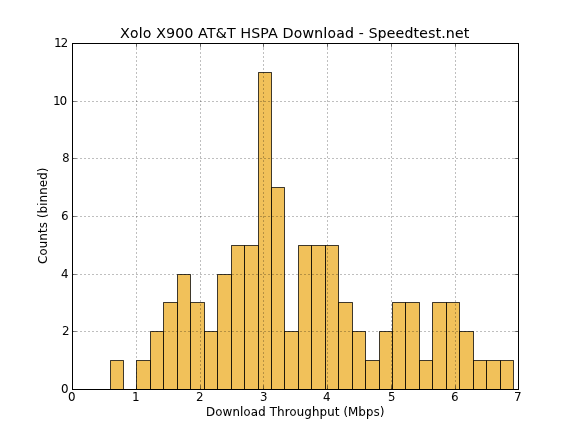
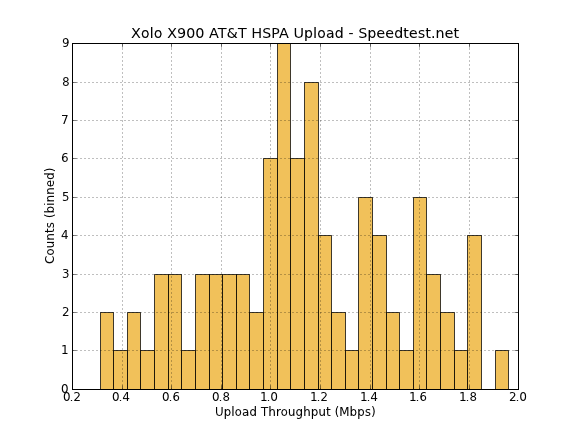
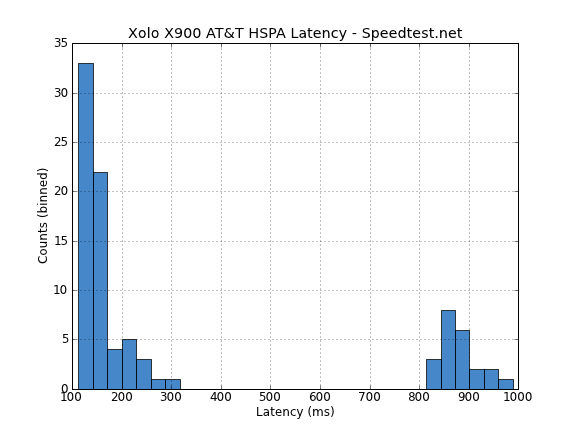
At this point HSPA+ 14.4 on AT&T is fairly well understood, running these is more validation that there’s nothing wrong with cellular on the device, and unsurprisingly there isn’t - again Intel knows how to implement its own baseband without issue, and with good performance.
WiFi
For WiFi and Bluetooth, the X900 uses a TI WiLink WL1271 series 6 combo chip which supplies 802.11b/g/n single spatial stream on 20 MHz channels with the short guard interval rate of 72 Mbps, and bluetooth 2.1 + EDR support. Some of the Intel documentation shows a TI WL1283 being used (which is WL 7.0 and includes a GPS baseband) and I don’t doubt that other Medfield platforms may implement WL128x or even WiLink 8 series with GNSS, however the X900 is definitely WL1271.
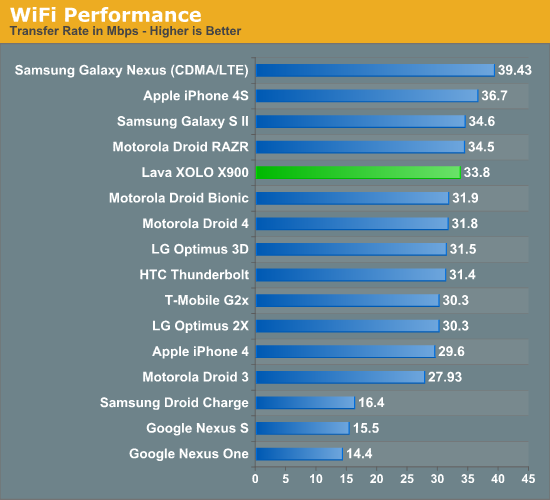
In our WiFi test which consists of a 100 MB PDF loaded over an 802.11n network, the WL1271 does pretty well, just as expected.
GPS
Like the TI WiLink series part, it seems that some Medfield designs include the WiLink 7 series with a GPS basbeand, and others include the more common SiRF Star 4 GSD4t GPS which we have seen in a ton of different smartphones, again including many Samsung phones.

I have no complaints with the GPS lock speed or quality on the X900, it’s speedy and accurate, and works well. I navigated around town with the device and never encountered any problems.
NFC
The X900 also includes NFC support, courtesy the ubiquitous NXP PN544 controller. The smartphone also includes the stock tag reader application, though NFC ships disabled. I tested it on the NFC tag sent with the Nexus S an eternity ago and it worked perfectly.

It’s safe to assume that with the Android 4.0 update beaming will be enabled.
Voice and Speakerphone
The X900 includes some common mode noise suppression components, including a primary and secondary microphone and an Audience eS305 voice processor.
We’ve seen the A102x series in devices before, including the Nexus One, iPhone 4, and numerous other popular smartphones. The reality is that good noise rejection so the far end hears nothing of the ambient sound around you is important both for making calls sound better, and also for increasing the idle or blanking periods on the reverse link. The X900 is my first time hearing the eS305 in action, and to test we did what we normally do by placing a call in front of some speakers, increasing volume, and speaking into the handset while recording the call on the far end on another handset.
I can’t emphasize enough that during the most taxing parts of this recording, I cannot hear myself speak at all. eS305’s performance is great, just like we’ve seen with their other solutions in devices where we’re able to identify its presence. The reality is also that using an array of microphones and some common mode noise rejection is basically the status quo for a high end smartphone right now.
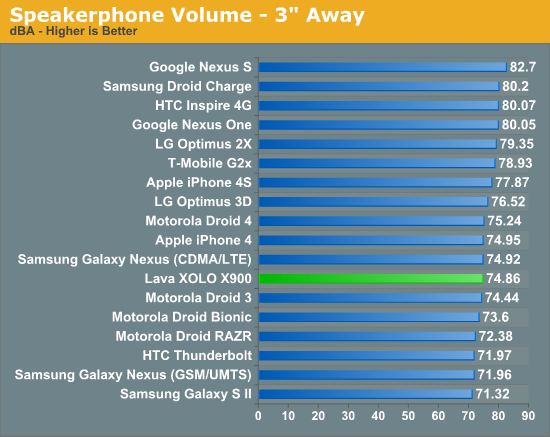
Speakerphone on the X900 is split between the two bottom speaker jacks, and isn't quite as loud as I'd like. We measured as usual with an Extech digital sound data logger 3 inches above the device.


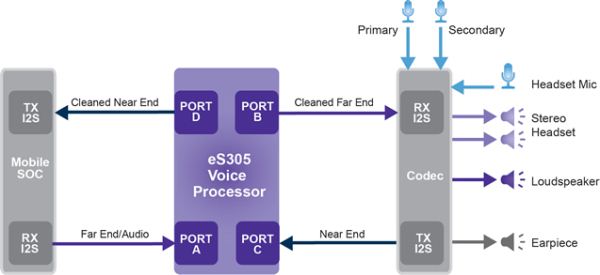








106 Comments
View All Comments
kyuu - Wednesday, April 25, 2012 - link
I dunno what review you all were reading, but I didn't see average performance. I saw it pretty much beating everything else save the HTC One S/X with only a single-core and running an old version of Android. Wth ICS, it'd probably be at the top easily.Sure, ARM isn't sitting still, but is Intel. I have no desire to see Intel overtake the market, but I can easily see Intel being the performance king by a good margin in the mobile SoC market when they release their next SoC.
Also, for people saying cost is a factor... do you have any source to back up the claim that Intel's SoC is significantly more costly? All I see are assumptions.
kyuu - Wednesday, April 25, 2012 - link
That's "neither is Intel" in the second paragraph, first sentence.UpSpin - Thursday, April 26, 2012 - link
SunSpider and Browsermark results are that good because of software tweaks done by Intel. Intel tweaked a lot in software, thus I doubt that ICS will improve anything further.Linpack single threaded, that's the most important benchmark to compare raw processing power without software tweaks. It shows that Medifield is faster than ARM A9, a good sign, but slower than Krait and thus all soon to get released A15 cores, a bad sign.
Linpack multi threaded shows that Medfield has not the slightest chance vs. Krait and ARM A15, most of them will be dual core SoCs, but even if they get produced in single core varients they will be faster (Linpack single threaded). Medifield also gets beaten by Quad Core A9 chips (all new high end smartphones pack either a Quad Core A9, or dual Core krait/A15). Medfield is at best, as fast as a dual core A9 (raw processing power).
Then take a look at the GPU: Poor performance for todays standards. Slower than the SGSII, slightly faster than the Galaxy Nexus, which has a slow GPU, too.
Power consumption: poor to average. (sadly we don't have numbers for Krait or Tegra 3 (HTC One X/S)
The SoC is not bad at all, but its release date is one year too late. This year is the year of Krait and A15, which beat Medfield in single threaded applications and are at least dual cores, so more than twice as fast. The integrated GPU is pretty weak, too, especially if you consider that this years ARM SoCs have a much better GPU.
Additionally x86, the advantage is huge software tweaks thanks to Intel, the disadvantage, custom skins/apps/features made by third party manufacturers won't run that easily.
Exophase - Friday, April 27, 2012 - link
Intel doesn't tweak Sunspider or Browsermark. But Javascript JIT performance is probably much better on x86 than ARM right now because it got a ton of attention on PCs from all major browser vendors, starting with the release of Chrome. And there's at least one major ARM improvement (EABI hardfloat) that's in V8 but didn't make it into official Android yet.Browsermark is only partially Javascript, but the other part (HTML5 rendering) is really lame too. Run it and you'll see what I mean, I hope.
Linpack is also a lousy benchmark. Any serious vector FP code on a phone (like matrix stuff for a game) would use SIMD with compiler intrinsics or ASM, and probably single precision over double precision. But even as a Dalvik double precision floating point test it sucks because it's not tiled and therefore heavily bandwidth limited.
Basically, most of the benchmarks used are awful.
clockerspiel - Wednesday, April 25, 2012 - link
The cell phone industry desparately needs a "flagship" representative for the Android ecosystem - and this ain't it!jjj - Wednesday, April 25, 2012 - link
You can't normalize battery life unless you factor in the screen size since the screen uses a lot of power and the handset's volume is directly related to the screen size and battery size.By normalizing you are making things worse than better.If you can't measure the power consumption for just the SoC you might as well just provide the system's battery life since,in the end, that's what matters anyway.
It is what it is,you can't take out the screen or the RAM or the NAND but that's no reason to make things worse with tests that distort the reality instead of helping.
menting - Wednesday, April 25, 2012 - link
uhh, it's not measuring the power consumption for the SoC, it's measuring the whole phone's power usage. So in this case, normalizing IS a valid way to go about this.plamengv - Wednesday, April 25, 2012 - link
It is beyond me why Intel will market x86 CPU with OS that has nothing to do with x86. The people who want Android will always go with the better looking and cheaper device. Something that this device is not. The other with knowledge will go for iPhone because there is no other alternative. Windows Phone is from professional point of view worse than Windows Mobile 6.5 and lacks lot of features. Intel had to bet on Windows 7 turning the smartphones into UMPC. Imagine Viliv S5 shrinked to Galaxy Note but running Windows 7! Well maybe Haswell and 22nm will finally make it.menting - Wednesday, April 25, 2012 - link
android was built from Linux..tell me where Linux has nothing to do with x86. And with future android versions including x86 compiles by default., x86 or not isn't an issue.The X900 is a reference design, who says other companies can't put a different external case on it? And where's proof that it will be more expensive?
superPC - Thursday, April 26, 2012 - link
why windows 7? windows 8 would be a lot better suited for something similar with this phone (with compatible GPU).